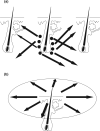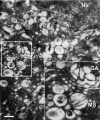What causes alopecia areata?
- PMID: 23947678
- PMCID: PMC4094373
- DOI: 10.1111/exd.12209
What causes alopecia areata?
Abstract
The pathobiology of alopecia areata (AA), one of the most frequent autoimmune diseases and a major unsolved clinical problem, has intrigued dermatologists, hair biologists and immunologists for decades. Simultaneously, both affected patients and the physicians who take care of them are increasingly frustrated that there is still no fully satisfactory treatment. Much of this frustration results from the fact that the pathobiology of AA remains unclear, and no single AA pathogenesis concept can claim to be universally accepted. In fact, some investigators still harbour doubts whether this even is an autoimmune disease, and the relative importance of CD8(+) T cells, CD4(+) T cells and NKGD2(+) NK or NKT cells and the exact role of genetic factors in AA pathogenesis remain bones of contention. Also, is AA one disease, a spectrum of distinct disease entities or only a response pattern of normal hair follicles to immunologically mediated damage? During the past decade, substantial progress has been made in basic AA-related research, in the development of new models for translationally relevant AA research and in the identification of new therapeutic agents and targets for future AA management. This calls for a re-evaluation and public debate of currently prevalent AA pathobiology concepts. The present Controversies feature takes on this challenge, hoping to attract more skin biologists, immunologists and professional autoimmunity experts to this biologically fascinating and clinically important model disease.
© 2013 John Wiley & Sons A/S. Published by John Wiley & Sons Ltd.
Figures






References
Publication types
MeSH terms
Grants and funding
LinkOut - more resources
Full Text Sources
Other Literature Sources
Medical
Research Materials
Miscellaneous

